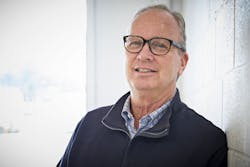MARINA AUTO BODY CUSTOMER CARE CENTER
LOCATION: MARINA DEL REY, CALIF.
SIZE: 3,000 SQUARE FEET
STAFF: 2 ESTIMATORS, 2 SUPPORT-STAFF MEMBERS, 1 PICK-UP/DELIVERY COORDINATOR
AVERAGE MONTHLY CAR COUNT: 150 (ESTIMATED)
When a client drives into Marina Auto Body’s new, 3,000-square-foot customer care center, which opened in January, they aren’t greeted with the usual noise that accompanies a collision repair center. And that’s exactly what owner Tom Williamson envisioned when he purchased an old mechanical repair service facility in Marina del Rey, Calif.
After opening a nearly 27,000-square-foot collision repair center near LAX (in Inglewood) in mid-2015, Williamson decided to add the new customer care center, which is located roughly 5 miles away from the other facilities in his three-location business. It’s all part of a “hub-and-spoke” system—a concept in which a repair center is centralized, with estimating centers on the perimeter of it—that Williamson envisions will help his MSO reach unprecedented levels of efficiency.
“If we can make [our facility] close to a customer’s home, or work, where they can drop off their vehicle, and take that nuisance away from them, I believe we win and they win,” the owner explains.
The new customer care center has few wasted elements. For example, the new shop features: just a couple estimators, a pair of support staff members, an employee dedicated to coordinating the pickup and delivery of vehicles, a drive-thru area to facilitate swift estimates, refurbished office space, and parking for five vehicles inside and six outside. There are no lifts on site, because no repairs are done at the facility.
The customer care center’s main purpose is to simply funnel vehicles to Marina Auto Body’s large repair center in Inglewood.
Williamson has run the MSO successfully since 1999, but feels incorporating compact customer care facilities might be necessary moving forward, given how the real estate market is trending in urban areas like Los Angeles. That area is less than welcoming of collision repair shops these days, due to restrictions—body shops aren’t permitted within 500 feet of a residence in L.A.—and real estate costs that have nearly quadrupled in recent years. Plus, the shop operator had heard of hub-and-spoke systems working smoothly elsewhere, such as with dealer groups.
“What drove me to [adapting the hub-and-spoke model] is watching what’s happening with real estate prices,” Williamson says. “So this is the alternative: Let’s find smaller square footage, where we’re efficient about getting cars in and out of the repair center, and then make it convenient for the customer.”
Being Proactive
Williamson spent the last couple years on the offensive professionally, watching competitors fall by the wayside.
“Municipalities don’t want body shops,” says the owner, who also noted that L.A. doesn’t allow spray booth permits within 500 feet of a residence. “What’s happening in the west side of Los Angeles: Anything that’s an industrial building, we see it’s going away. They convert the building to creative office space. … If we have rent here at some of these industrial spaces for $4 a square foot, the margins aren’t in our business to be able to conduct a collision repair facility like that.
“So, what I’ve witnessed now in the last year and a half, is four collision centers around me, of different sizes, closing.”
Williamson, whose two other Marina Auto Body locations do a combined $12 million per year, wanted to maintain a presence in the western part of Greater Los Angeles. He certainly didn’t want to spend years trying to cultivate a new customer base elsewhere.
There’s only one other customer care center in Los Angeles, which also added to the appeal of that concept for the industry veteran. Plus, by utilizing one large hub for repairs by LAX, Williamson can have that busy facility operate for 14 hours a day, aided by a split shift.
“I don’t really think most customers care where their car is being repaired,” Williamson notes. “They just want to know that it’s someone reliable—I think that gives customers a little comfort to say, ‘We understand, we get it, you’ve always done right. We’re leaving our car here, and let’s go.’”
DEFINING A HUB-AND-SPOKE SYSTEM
The spoke-hub distribution model features a system of connections arranged like a wire wheel, in which traffic flows to the “hub” at the center. Essentially, a large facility acts as a business’ hub, with associated, smaller facilities benefiting from its presence and arranged around the hub like the spokes of a wheel. A chief benefit of this system: time-consuming operations can be carried out at the hub, rather than at every business location.
Plotting a Path
Williamson studied the “hub-and-spoke” system for months before his new customer care center came to fruition. As a result, the owner has developed multiple streamlined processes for the facility.
Estimates are written. Appointments are made. Vehicles are dropped off. Customers are connected with rental companies. Cars are transported to the larger Marina Auto Body repair center near LAX.
Claims information is inputted, and then the repair center is notified that a vehicle is in transit. Additionally, Williamson stresses the importance of having his designated customer care employee and the file handler at the repair center communicate daily, so that they can relay information to the customer. The new facility, which also gets direct repair program assignments, may boast an Enterprise rental presence before long.
“The customer’s time is valuable, so you try to ease that process,” the owner explains. “They’re dropping off their car … and they’re not sitting. Our customers, they don’t want to sit for 15 minutes; they’re busy and they want to get going.”
Communication is paramount among a customer care facility’s small staff, Williamson says.
“It’s just going to be about keeping people on task, that we understand the process and follow the process each and every time,” he says. “There are a number of steps that you always have to go through to make sure that all the information’s seamless, that the repairs are done, and that the quality control is in place.
“We understand the communication, we understand the quality control that it’s going to take."
Moving Forward
The customer care center in Marina del Rey is a fledgling facility, but its owner is optimistic about its future. Williamson expects an average of 7-8 vehicles of intake per day before long.
“It looks to me as if the return on investment is going to be tremendous, as long as we can provide the proper service,”Williamson says. “Because, you know, we run collision centers maybe efficiently for nine hours a day. You pay rent 24 hours a day. And, if we can get 14 efficient hours a day through a split shift in the repair center, rather than having two repair centers, there’s a real efficiency there.”
It costs most owners well over a million dollars to build a collision center these days. That’s why Williamson feels like an owner needs to run two shifts per day to maximize return on investment. Marina Auto Body’s owner also expects to see a legitimate ROI quickly due to his business’s loyal customer base, as well as insurance partners that understand his reasoning behind adapting the hub-and-spoke concept.
So far, Williamson sounds both content and energized by his investment in Marina Auto Body’s new customer care center. In fact, he’s already pondering possible locations for a similar facility.
“It’s going to have its ups and downs,” Williamson said of the project, “and we’ll work through them and do what’s best for the customer. So, we’ll see. … I don’t see any reason for it to not be successful.
“There’s nothing to lose, everything to gain.”
About the Author

